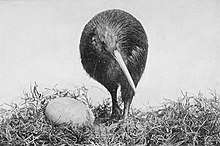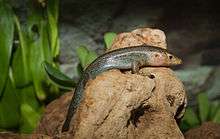Paleoendemism
Paleoendemism along with neoendemism is one of two sub-categories of endemism. Paleoendemism refers to species that were formerly widespread but are now restricted to a smaller area. Neoendemism refers to species that have recently arisen, such as through divergence and reproductive isolation or through hybridization and polyploidy in plants.[1]
Etymology
The first part of the word, paleo, comes from the Greek word palaiós, meaning "ancient".[2] The second part of the word, endemism is from New Latin endēmicus, from Greek ενδήμος, endēmos, "native". Endēmos is formed of en meaning "in", and dēmos meaning "the people".[3]
Causes
Changes in climate are thought to be the driving force in creating endemic species, generally due to habitat loss. Regions where past climate change has been relatively stable with low extinction rates are more like to be endemic hotspots today.[4] To qualify as hotspot, geographical areas have to have more than 0.5% of the world's plant species endemic to the region.[5] These causes apply to both neoendemism and paleoendemism. However, paleoendemism differs as it does not require additional factors such as barriers and ecological opportunities as it does not rely on adaptive radiation like neoendemism does.[4] It instead relies on the instability of other regions' climate, which may limit the range of a species to a more stable region, thus turning that species paleoendemic. Limited ability for dispersal is also important in the creation of endemic species.[6] The two terms can essentially be defined as "cradles" of new species (neoendemism), or "museums" of old species (paleoendemism).[4]
Anthropogenic causes
There are also several human related causes to paleoendemism. Anthropogenic deforestation can severely restrict a species' habitat.[7] In countries like Madagascar, a biodiversity hotspot with extreme proportions of endemism, where only 10% of the island's original forest cover is still intact, this can also lead to extinctions.[8] Pollution, urbanization, and agricultural growth may also turn areas inhabitable for certain species, restricting their habitat in a similar way as deforestation. Human introduction of new predators, whether it be accidental or not, destabilizes ecosystems and can lead to the creation of paleoendemic species in undisturbed regions.[7] In many cases today, paleoendemism is essentially a stepping stone into extinction, especially for those caused by anthropogenic disturbances.
Conservation efforts
Endemism as a whole is often used to measure biodiversity.[9] While this is not entirely correct, high levels of endemism is one of the required components of a biodiversity hot spot.[5] Conservation efforts tend to be focused around these hot spots, and as result, endemic species reap many of the benefits. This association between biodiversity and endemism also works in the opposite way, where many conservation groups tend to pick areas to focus on based on their endemism rate.[9]
Examples

It is not always clear whether a particular species is paleoendemic or neoendemic. For example, kiwis, which are confined to New Zealand, were cited as examples of paleoendemism, this has since been proven to be untrue. Kiwis are ratites (a group of flightless birds). Most parts of the former supercontinent Gondwana have ratites, or did have until the fairly recent past. The traditional account of ratite evolution has the group emerging in flightless form in Gondwana in the Cretaceous, then evolving in their separate directions as the continents drifted apart. More recently, it has been suggested that ratites lost the ability to fly multiple times, and the proto-kiwi developed an inability to fly after arrival in New Zealand. “Overwater dispersal” has been hypothesised for the arrival of the kiwis' ancestor in New Zealand.[10]
Ginkgos are a paleoendemic genus. From the Mesozoic to the mid-Cenozoic, these trees could be found throughout the world. However, today, they can only be found in Japan and China in the wild.[11]
Paleoendemism on islands
Islands offer classic examples of paleoendemism. For this purpose, an island is an area of habitat that is suitable for an organism surrounded on all sides by habitat that is unsuitable.[1] Islands as harbors for endemic species are explained by the Theory of Island Biogeography. However, in order to be considered a paleoendemic on an island, the species must have had a widespread distribution previously,[2] thus eliminating newly formed islands as potential refuges of paleo-endemics.
Geographical islands

For example, on the Canary Islands, there are a large number of relict plant species that were formerly distributed in Europe and North Africa. Of the 88 critically endangered species on the Canary Islands, many are the result of range reductions on the islands.[3] The island of New Caledonia is also a prime example as many of the species on the island are paleoendemics. The palm species on New Caledonia grow in areas that are likely former Pleistocene refugia of lowland rainforests.[12] Islands are also a refuge for relict lineages of animals. Bermuda has a high diversity of species and home to one species of terrestrial vertebrate, the skink Plestiodon longirostris, which is the only extant lineage of mainland North American Plestiodon lineages.[13]
The Scorpion of Montecristo (Euscorpius oglasae) from the small Italian island of the same name is likely a paleoendemic species. Glaciations during the Pleistocene are unlikely to have created land bridges between the 10.39 km2 island and the Italian mainland, isolating the species for tens of thousands of years.[14]
Soil (edapphic) islands
.jpg)
Many soil types harbor diverse and endemic plant species. Specific soil types act as “islands” of fertility and the distribution of these soils leads to high rates of paleo- and neoendemism.[15] The primary example of this is serpentine soils.[15][16] These soils are found in Balkan Peninsula, Turkey, Alps, Cuba, New Caledonia, the North American Appalachians, and a scattered distribution in California, Oregon, and Washington and elsewhere[14] For example in the serpentine soil patches in the Pacific Northwest, Steptanthus glandulosus subsp. glandulosus is a paleoendemic, though the closely related members of the species complex are widely distributed.[16]
Mountain islands
Mountains can also be “islands” and harbors of paleoendemism because species that live on mountain peaks are geographically isolated.[17] For example, in the Maritime Alps, Saxifraga florulenta, is an endemic plant that evolved in the Late Miocene and was once widespread across the Mediterranean Basin.[17] Additionally, Piper’s bellflower (Campanula piperi) in the Olympic Mountains in Northern Washington is suspected to be a paleoendemic because the closest related species is located over 1,000 km away. Another example is Stroganowia tiehmii which is endemic to a single mountain range in Nevada [18] and all other members of the genus are in Central Asia.[19]
See also
References
- MacArthur, Robert H.; Wilson, Edward O. (2001-03-18). The Theory of Island Biogeography. Princeton University Press. ISBN 9780691088365. Retrieved 2019-03-06.
- Stebbins, G. Ledyard; Major, Jack (1965). "Endemism and Speciation in the California Flora". Ecological Monographs. 35 (1): 2–35. doi:10.2307/1942216. JSTOR 1942216.
- Vargas, Pablo (2007). "Are Macaronesian islands refugia of relict plant lineages?: A molecular survey". Phylogeography of Southern European Refugia. pp. 297–314. doi:10.1007/1-4020-4904-8_11. ISBN 978-1-4020-4903-3.
- Harrison, Susan; Noss, Reed (January 2017). "Endemism hotspots are linked to stable climatic refugia". Annals of Botany. 119 (2): 207–14. doi:10.1093/aob/mcw248. PMC 5321063. PMID 28064195.
- Myers, Norman; Mittermeier, Russell A.; Mittermeier, Cristina G.; da Fonseca, Gustavo A. B.; Kent, Jennifer (February 2000). "Biodiversity hotspots for conservation priorities". Nature. 403 (6772): 853–8. Bibcode:2000Natur.403..853M. doi:10.1038/35002501. PMID 10706275.
- Sandel, B.; Arge, L.; Dalsgaard, B.; Davies, R. G.; Gaston, K. J.; Sutherland, W. J.; Svenning, J.- C. (6 October 2011). "The Influence of Late Quaternary Climate-Change Velocity on Species Endemism". Science. 334 (6056): 660–4. Bibcode:2011Sci...334..660S. doi:10.1126/science.1210173. PMID 21979937.
- "Here's Everything You Need to Know About Endemic Species". AnimalSake. Retrieved 2019-03-17.
- Hanski, Ilkka; Koivulehto, Helena; Cameron, Alison; Rahagalala, Pierre (22 June 2007). "Deforestation and apparent extinctions of endemic forest beetles in Madagascar". Biology Letters. 3 (3): 344–347. doi:10.1098/rsbl.2007.0043. PMC 1995085. PMID 17341451.
- "Endemism as a Surrogate for Biodiversity". Conservation. 2008-07-29. Retrieved 2019-03-21.
- Choi CQ (2014). "Tiny Kiwi and giant Elephant Bird are close cousins". Scientific American. Retrieved 7 November 2015.
- Royer, Dana L.; Hickey, Leo J.; Wing, Scott L. (March 2003). "Ecological conservatism in the 'living fossil' Ginkgo". Paleobiology. 29 (1): 84–104. doi:10.1666/0094-8373(2003)029<0084:ECITLF>2.0.CO;2.
- Pintaud, Jean-Christophe; Jaffré, Tanguy; Puig, Henri (May 2001). "Chorology of New Caledonian palms and possible evidence of Pleistocene rain forest refugia". Comptes Rendus de l'Académie des Sciences, Série III. 324 (5): 453–463. doi:10.1016/S0764-4469(01)01312-9.
- Brandley, Matthew C.; Wang, Yuezhao; Guo, Xianguang; Nieto Montes de Oca, Adrián; Fería Ortíz, Manuel; Hikida, Tsutomu; Ota, Hidetoshi; Rankin, Daniel J. (30 June 2010). "Bermuda as an Evolutionary Life Raft for an Ancient Lineage of Endangered Lizards". PLoS ONE. 5 (6): e11375. Bibcode:2010PLoSO...511375B. doi:10.1371/journal.pone.0011375. PMC 2894854. PMID 20614024.
- Kruckeberg, Arthur R (2002). Geology and plant life: the effects of landforms and rock types on plants. Seattle: University of Washington Press. ISBN 978-0-295-98203-8. OCLC 475373672.
- Anacker, Brian L. (February 2014). "The nature of serpentine endemism". American Journal of Botany. 101 (2): 219–224. doi:10.3732/ajb.1300349. PMID 24509800.
- Mayer, Michael S.; Soltis, Pamela S. (October 1994). "The Evolution of Serpentine Endemics: A Chloroplast DNA Phylogeny of the Streptanthus glandulosus Complex (Cruciferae)". Systematic Botany. 19 (4): 557–74. doi:10.2307/2419777. JSTOR 2419777.
- Comes, Hans Peter (1 September 2004). "The Mediterranean region - a hotspot for plant biogeographic research". New Phytologist. 164 (1): 11–14. doi:10.1111/j.1469-8137.2004.01194.x.
- "Stroganowia tiehmii | Nevada Natural Heritage Program". heritage.nv.gov. Retrieved 2019-03-12.
- "Stroganowia in Flora of China @ efloras.org". www.efloras.org. Retrieved 2019-03-12.